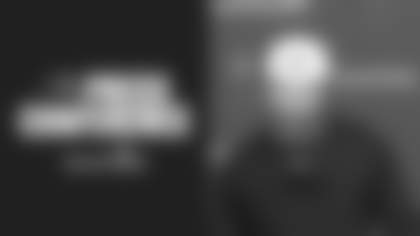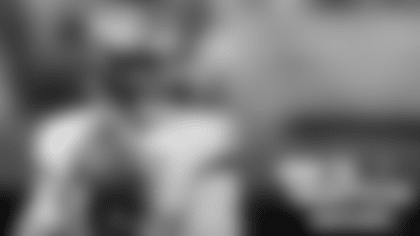The Buc fans' inside source digs into Buccaneer trade history and also touches on such topics as the draft (of course), bye weeks, battered helmets and even a little soccer
The Scouting Combine is over, free agency has begun and 32 teams are barreling down on the best weekend of the offseason: The NFL Draft.
These days, the draft brings with it unending analysis, hundreds of mock drafts and a lot of posturing by NFL front offices. And the Answer Man loves every minute of it.
What isn't as much fun this time of year is the Answer Man's mailbag, which gets stuffed with Buccaneer draft-related questions. Don't get me wrong: They're valid questions. There's just not much I can do with them. As you'll see below, I've taken the opportunity in this column to repeat my annual explanation of why so many of those questions go unanswered.
"Who will the Buccaneers take in the first round?" "What position are we looking at in the first round?" "Do the Bucs like Player X?" All good questions, worthy of the long debate they'll get over the next eight weeks, but not fodder for this column, as I explain below.
In my explanation, I do mention that I would be happy to delve into other areas of this draft topic, things such as Buccaneer history or procedural issues. What do I mean by that? Let me give a couple examples before I get down to the business of answering your questions below.
How many times have the Bucs had the first overall pick in the draft, and who did they get?
Answer Man: The Bucs have started the draft on four occasions, and not surprisingly that includes their first two years, 1976 and 1977. They would have also picked first in 1978 if not for a trade with Houston that is explored in more detail below. The Bucs picked first overall in 1986 and 1987, as well. The four players gained with those picks were Lee Roy Selmon, Ricky Bell, Bo Jackson and Vinny Testaverde.
That's a foursome that certainly runs the gamut. Selmon, of course, was everything the team had hoped for and more; he's now enshrined in the Pro Football Hall of Fame. Jackson, on the other hand, eschewed the Bucs for baseball, then eventually entered the NFL with the Oakland Raiders. Bell and Testaverde are well represented in the Bucs' record books.
How are compensatory picks determined?
Answer Man: Each year, usually in late March, the NFL announces a list of compensatory picks that have been awarded to about half of the league's teams. These picks fall between rounds (technically, they are additional picks on the end of each round), starting with the third and continuing through the seventh. Most of them come at the end of the sixth and seventh rounds, and these picks cannot be traded.
Compensatory picks are a byproduct of the NFL's free agency system. As free agent players find new addresses each year, there are always going to be some teams that gain more than they lose through the system, and vice versa. Compensatory picks are awarded to teams who lose more than they gain in free agency, using a formula developed and applied by the NFL Management Council. Frankly, the Answer Man doesn't understand all the details of the formula, but I don't think it's all that necessary to know. Last year, the Bucs signed two players who were technically unrestricted free agents (Anthony Becht and Chris Hovan) and lost six (Keith Burns, Cosey Coleman, Chartric Darby, Charles Lee, Matt O'Dwyer and Dwight Smith). That looks like a net loss, so the Bucs will probably get a compensatory pick or two this year. Stay tuned for that information on Buccaneers.com this month.
Who is the last "Mr. Irrelevant" to make a significant impact in the league?
Answer Man: If you don't know, "Mr. Irrelevant" is the title bestowed each year on the last player taken in the draft, thanks to the decades-long efforts of one free-spirited soul named Paul Salata. Each year, this guy gets a lot of attention during the week after the draft, but obviously, given his draft position, he often remains fairly obscure after that.
Still, it's not that unusual for a seventh-round pick to make it in the league, so it stands to reason that some Mr. Irrelevants would go on to have nice careers. I would have to say that the most accomplished Mr. Irrelevant in recent years is Chicago Bears safety Michael Green.
Green was drafted 254th overall out of Northwest Louisiana in 2000. He has stuck with the Bears for six years already, playing in 81 games and contributing 392 tackles, six sacks and four interceptions. He was a starter for all of 2002 and 2004 and parts of '01, 03 and '05. That is a pick well-spent.
It's not necessarily fair to write off the most recent Mr. Irrelevants just yet. TE Andy Stokes (Patriots, 2005), LB Andre Sommersell (Raiders, 2004) and WR Ryan Hoag (Raiders, 2003) haven't really established themselves yet but still could. None of them, though, are still with the teams that drafted them. The same is true of the other two M.I.'s since Green, DT Ahmad Miller (Texans, 2002) and TE Tevita Ofahengaue (Cardinals, 2001).
The Bucs picked Mr. Irrelevant in 1993, but punter Daron Alcorn, who has ended up with a long Arena Football League career. One of the more accomplished M.I.s was Matt Elliott, an offensive lineman taken last in 1992 by the Washington Redskins, and that's when the draft was still 12 rounds long. Elliott stuck with the 'Skins in 1992 and eventually ended up as a starter in Carolina for most of the 1995-97 seasons.
Okay, obviously I'm just throwing out questions to which I already know the answer. You may be able to do better. The point is, the draft itself isn't off limits for me, just any discussion of who the Bucs intend to select. Keep the questions coming, about that topic and any other Buc or NFL-related issues that have you puzzled.
Now on to this week's batch.
**
- Carlos Escobedo of Atlanta, Georgia asks:
**Okay, we can all see that the trade for Joey Galloway worked out well for the Buccaneers. The guy's a stud, and I guess you could say the team killed two birds with one stone on that one.
My question is, how often do trades like this work out? It doesn't seem like there really is a lot of trading in the NFL, and I can't remember the last big-time contributor the Bucs got in a trade…maybe Thomas Jones. I think I recall we got him in a trade. Okay, maybe my question is, what is the best trade the Bucs have ever made, in terms of getting a player? Is it Galloway? What's the best trade overall, considering all the implications? What's the worst deal, if you're willing to answer that one? You're Mr. Research…go back into the archives and tell us how the Bucs have done at the swap meet.**
Answer Man: Oh, now that is a rich topic, Carlos, and excuse me for saying so but you didn't really define too clearly how you want me to approach it. It is true that trades are relatively uncommon in the NFL when compared to, say, MLB or the NHL. Still, that's relatively uncommon. The Buccaneers' media guide lists hundreds of trades over the years, though many ended up being relatively minor.
Besides separating the major ones (two first-round picks for Keyshawn Johnson) from the minor ones (a 12th-round pick for Joe Ferguson), you can put the trades into four basic categories:
- Player(s) for player(s). These are the rarest kind, which was what made the Galloway-Johnson trade something of a surprise at the time. The Bucs have actually pulled off two such deals in the last three years, also snaring RB Thomas Jones from Arizona for WR Marquise Walker (uh, that was a win). Before that, though, the previous two player-for-player trades executed by the Bucs were P David Leaverton-for-WR Jonathan Pittman in 2002 and CB Roderick Jones-for-DE Jim Skow in 1990. If you don't remember which two players the Bucs got in those deals, you get an idea of how earth-shaking they were (for the record, the Bucs got Leaverton and Skow for Pittman and Jones). 2. Pick(s) for player(s). These are somewhat more common, if only because teams often fall into a situation where they are determined to move a player (Keenan McCardell) and the obvious return is a draft pick. The most recent such trade for the Buccaneers was the acquisition of QB Luke McCown for a sixth-round pick during last year's draft. The last time the Bucs traded a player to get a pick was the McCardell deal, which netted third and sixth-round picks in 2005. 3. Draft positioning. These are by far the most common, as teams move up and down in the draft in order to grab a particular player or pick up extra selections. Few drafts go by without the Bucs doing this at least once. Last year, they traded down a bit in the fifth round and got an extra seventh out of it, which they eventually used on safety Hamza Abdullah. 4. Special circumstances. I added this one basically to cover such deals as the four draft picks the Bucs sent to Oakland in 2002 in order to get the rights to hire Head Coach Jon Gruden. A deal like this recently went down between Kansas City and the New York Jets for Herman Edwards; we could call them "compensation" trades.
There are, of course, combinations of these deals. A team might trade a player and a pick in order to move up in the draft, for instance, such as when the Bucs sent FB Darian Barnes and their seventh to Dallas in 2004 in order to move up 10 spots in the final round and grab WR Mark Jones. Or two teams might swap players, but one side has to sweeten the deal with a draft pick on their end. In 1983 the Bucs sent T Charley Hannah to the Raiders and got DE Dave Browning back, plus a fourth-round pick.
The Bucs have had (sometimes spectacular) successes and failures in each category. Let's see if I can distill your letter into a series of straightforward questions, then provide answers as best I can.
Is the 2004 trade for Joey Galloway the best trade the Bucs have ever made, in terms of getting an established player?
Well, my first answer is "too soon to tell." Galloway has played, basically, a season and a half for the Bucs so far, so that's just not enough evidence yet. However, I think it's fair to say that his acquisition already ranks up there among the best, with the chance to finish on top.
Without getting into the specifics of each deal, here are some other established players that the Bucs have netted through trades down through the years: RB Thomas Jones (2003); WR Keyshawn Johnson (2000); QB Eric Zeier (1999); FB Lorenzo Neal (1998); S Thomas Everett (1994); LB Jimmy Williams (1992); LB Jesse Solomon (1991); RB Gary Anderson and QB Chris Chandler (1990); S Mark Robinson and LB Eugene Marve (1988); QB Steve DeBerg (1984); QB Jack Thompson (1983); DT Wally Chambers, TE Jimmie Giles and TE Jim Obradovich (1978); QB Steve Spurrier, CB Mike Washington and LB Richard Wood (1976).
A few quick observations off that list.
One, most of those deals worked out for the Buccaneers, but usually just for a short period of time. Players like Everett, Williams and Anderson were near the ends of good careers, and they gave the Bucs a season or two before retiring. The most notable players that did not work out in the list above were quarterbacks, particularly Chandler and Thompson. More on that later.
Two, Giles might be the most accomplished player on that list, so you could say he's the best answer to the above question (with apologies to Johnson, Robinson, DeBerg and, especially, Washington and Wood). However, was the trade to acquire Giles a complete home run? The Bucs loved everything about the Galloway trade, since they were sending Dallas a player they no longer wanted on the team (though Johnson has continued to succeed for the Cowboys, so they probably like the deal, too). But to get Giles from Houston the Bucs traded down from the first overall pick in 1978 to the 17th pick, and also picked up three additional picks (a second in 1978 and a third and a fifth in 1979). The Oilers used the first overall pick to select eventual Hall-of-Famer Earl Campbell, while the Bucs' four picks netted QB Doug Williams, G Brett Moritz, DE Reggie Lewis and QB Chuck Fusina.
The Bucs got almost nothing out of Moritz, Lewis and Fusina, a total of 35 games played and no starts between them. So the end result of the deal was Doug Williams and Jimmie Giles for Earl Campbell. The trade certainly worked out for both teams – Williams and Giles emerged as two of the best players in franchise history – but it's hard to call that deal a no-brainer if you were making it today.
The Bucs gave up a third-round pick to get Mike Washington and a seventh-round pick to get Richard Wood. Both players stayed with the team for nine seasons and were key members of the league's number-one ranked defense in 1979, when the Bucs first made the playoffs and advanced all the way to the NFC Championship Game. Washington started 97 games for Tampa Bay, Wood 89. Washington is tied for third on the Bucs' all-time interceptions list; Wood is fourth on the career tackle chart. Galloway may eventually be the best answer to the above question, but for now the Answer Man will have to go with Washington and Wood.
What is the best trade the Bucs have ever made, period?
Again, the Galloway trade makes it into the discussion, and is only likely to get better. But the Answer Man is going to have to hedge on the answer just a bit, because there was a closely-related series of trades in 1995 that is my pick for the top of the list.
First, some honorable mentions, in no particular order.
- In 1996 and 1998, the Bucs eagerly agreed to trade second-round picks to San Diego for the Chargers' first-round picks in 1997 and 2000, respectively. The Answer Man says you do the deal any time a team comes calling, unless you have your heart dead set on a player who is surprisingly available to you in that current round two. The Chargers used those two second-round picks on WR Bryan Still (1996) and WR Mikhael Ricks. Still never got much of a career going and Ricks bounced around the league for awhile, eventually converting to tight end. The Bucs used their extra first-rounder in 1997 on WR Reidel Anthony and their extra first-rounder in 2000 to package with their own first-rounder to get Keyshawn Johnson.
- Lo Neal for a fifth-rounder in 1998 was a steal, considering Neal's iron-headed blocking helped lead the Bucs to the fourth-best rushing attack in the NFL that year. The Bucs were 11th the year before and 15th the next year, after Neal had departed. The returns on that one didn't last long, but were very noticeable.
- The Colts gave Tampa Bay a first-round pick in 1996 in order to get Craig Erickson. The Bucs were going to go with Trent Dilfer and they used that first-round pick on Marcus Jones. Considering Erickson's relatively short stay with Indianapolis, that deal worked out very well.
- The Bucs traded down seven spots in the second round with Buffalo in 1987 and still got CB Ricky Reynolds, while the Bills wanted CB Nate Odomes. Both players worked out well for their teams and the extra fourth the Bucs picked up was used on TE Ron Hall, who became a Tampa Bay mainstay for years.
- The aforementioned Washington and Wood pickups. The Bucs also traded S Cedric Brown to Oakland in 1977 for sixth and ninth-round picks. That deal worked because not only did the Bucs get two relatively useful players with those picks in QB Gary Huff and WR Larry Mucker, but they also got Brown back at the start of the 1978 season after he was cut by the Raiders. Brown went on to start 95 games for the Bucs and intercept 29 passes, second-most in franchise history.
- This one almost takes the cake: In 1995, the Bucs traded tight end Harold Bishop to Cleveland for a high second-round pick. Now, Bishop had been drafted by the Bucs in the third round the year before, but hadn't really worked out, playing in just six games without a catch. Somehow, they were able to move him a year later for that second-rounder, which eventually also made it easier to trade their own second-round pick to the Chargers in that deal mentioned above. Bishop would last just two seasons with the Browns/Ravens, making 18 catches. Now, class, can anyone tell me who the Bucs drafted high in the second round in 1996. Exactly, Mike Alstott. Enough said.
But the best Buccaneer trade, in the Answer Man's opinion, was actually a series of deals made on the first day of the draft in 1995.
Heading into that draft, the Bucs were set to pick seventh in the first round and fifth in the second round. The needs on defense were glaring, and the Bucs had targeted a few players they believed could be special. When Tampa Bay's time on the clock came around, the phone lines were burning. Philadelphia wanted to move up to take, as it turns out, NFL Scouting Combine star Mike Mamula, a defensive end. The Bucs obliged by sliding back to 12th and throwing in a third-round pick in order to get two extra second-round picks from the Eagles.
DT Warren Sapp, a dominant player on the college level, fell into their laps at 12 when Minnesota opted for Florida State DE Derrick Alexander. As the first round progressed, the Bucs noticed another player they coveted, Florida State LB Derrick Brooks, dropping due to a perceived lack of size. Now armed with three second-round picks, the Bucs packaged the first and third of them together to get Dallas' first-round pick, the 28th overall. That's where the Bucs nabbed Brooks.
With their remaining second-round pick, the Bucs selected Kentucky S Melvin Johnson, who had two seasons as a starter before being traded to Kansas City.
To recap, the Bucs somehow turned the seventh, 38th and 69th picks into the draft into the 12th, 28th and 43rd and ended up with the cornerstones of their soon-to-be-dominant defense, plus an additional starter. That was a fine day of dealing.
What is the worst trade in Buccaneer history?
It's not the Answer Man's style to dwell on the negative when it comes to my own team, but I suppose we can touch on this briefly. We should point out that every team has a bad deal or two in its past. There are no guarantees in this business of trading, so every now and then one's best-laid plans are going to go awry.
It's safe to say the Bucs would like to rescind those first-round-pick trades they made to get Thompson and Chandler, two quarterbacks that were supposed to solidify the position but never really worked out. Chandler has had a respectable NFL career, of course, but his two years in Tampa (1990-91) in competition with Vinny Testaverde for the starting job were contentious and rarely fruitful. The worst part was, the pick to get Chandler ended up being the second one overall in the 1992 draft. Indy actually ended up with the first two picks in that draft, a gold mine that famously didn't work out as well as expected when the Colts took DT Steve Emtman and LB Quentin Coryatt.
A couple other deals were basically forced by strife between player and team, such as the trade of G Sean Farrell to New England for a second-round pick in 1987. The Bucs used that pick on Mississippi State RB Don Smith, who failed to make much of an impact. The same was true when LB Hugh Green was shipped to Miami midway through 1985 for first and second-round picks in 1986. The Bucs might feel better about that one if those picks hadn't been used on CB Rod Jones and LB Kevin Murphy.
The deal that sticks out, though, as particularly damaging was the shipment of a first-round pick in the 1983 draft to Chicago for a second-round pick in 1982. At the time, the Bucs were enthralled with Bethune-Cookman DE Booker Reese, and felt he had been worthy of a first-round pick. It's probably safe to say now that he wasn't; Reese played just three seasons in Tampa and started seven games.
Now, that Buccaneer pick in 1983 ended up being 18th overall, because Tampa Bay made the playoffs in 1982. However, as you might recall, that was a particularly deep draft, especially at quarterback. Yes, that was the John Elway/Todd Blackledge/Jim Kelly/Tony Eason/Ken O'Brien/Dan Marino draft. Other players in that first round included RBs Eric Dickerson, Curt Warner and Gary Anderson, G Bruce Matthews, Ss Gill Byrd and Joey Browner, CB Darrell Green, Ts Chris Hinton and Jimbo Covert, C Don Mosebar and DE Jim Jeffcoat. The Bears used the Bucs' pick on WR Willie Gault.
Yeah, that would have been a good draft in which to have a first-round pick. Perhaps the Bucs, having just lost Doug Williams to the USFL thanks to a contract dispute, would have gotten in on that quarterback run. After all, O'Brien went 24th and Marino, amazingly, went 27th.
Instead, the Bucs felt compelled to trade their 1984 first-round pick to Cincy for Thompson. That worked out so well that a year later the Bucs traded for DeBerg. Meanwhile, they had no first-round pick for the second year in a row, helping lead to a talent drain, which was exacerbated in 1986 when RB Bo Jackson, taken first overall, chose to go play baseball instead. The Bucs would have been picking first overall in 1984, but the pick eventually ended up in New England's hands and was used on WR Irving Fryar.
So, what do you think, Carlos? Did I provide your answer somewhere within all of that? Next time send a more focused question and you'll get a more focused answer. (Well, probably. I'm not promising anything.)
**
- Patrick of Dublin, Ireland asks:
Hello there Answer Man! I am a devout football fan and have been following the Buccaneers ever since they won the Super Bowl, and I have a rather small question. In both my Madden game and real life I noticed that nearly every time a Quarterback is in the shot-gun position he raises his knee before snapping the ball. Is this a requirement? THANKS!
Answer Man: You know, Patrick, I'm glad you asked that question because I almost forgot I had saved a nearly identical one from the last group to include here. You and the original questioner are from different sides of the pond, but you have almost the exact same observation. Here's his question…
Joe of Orlando, Florida asks:
Hey there you ol' shoe-shiner! OK now to my important question. I have long noticed that QB's always lift up one of their knees, while in the shotgun position, before they snap the ball. Is this a rule? Or just some sort of ritual that Johnny Unitas may have started? If you can answer my question, please do. Thanks!
Answer Man: No, Patrick and Joe, this is not a rule or a requirement. The quarterback does not have to lift one of his legs before taking the snap while in the shotgun formation. This movement is totally by choice.
It is, in effect, a timing mechanism. Most of the time the quarterback lifts his knee, he's doing so for the benefit of the center, who is peaking back through his crouch. In many cases, the team has agreed in the huddle that the snap will be, maybe, one beat after the quarterback lifts his leg. In other words, it's a silent count, based on timing not some word spoken by the quarterback. Watch more closely and you'll notice that the shotgun leg-lift is more prevalent for the visiting offense (but don't watch a Bucs game, because they never use the shotgun).
Of course, any amount of trickery can then be spawned from this base idea. The quarterback may have been using the leg-lift for much of the day, so he tells the huddle that he's going to go one beat after the second leg-lift. Anything to throw off the defense's timing and perhaps get a defender to jump offside.
**
- Hasan Harajli of Des Moines, Iowa asks:
**O Royal Seamless,
I was somewhat confused by your answer to a question regarding the forward pass. As you cited in your article:
"The offensive team may make one forward pass from behind the line during each play from scrimmage provided the ball does not cross the line and return behind the line prior to the pass. (a) Any other forward pass by either team is illegal and is a foul by the passing team."
That rule makes it sound like it is possible that two forward passes may be legal if the receiver of the first pass was to retract his way back behind the line of scrimmage. Or am I reading the rule wrong. The latter is more likely your faultlessness.**
Answer Man: "O Royal Seamless?" That's a new one. Makes me sound like the queen's undergarments. Anyway, I think I know what you mean and I do appreciate you giving me the benefit of the doubt. In this case, I can't even berate myself for poor wording, because that is excerpted directly from the Rulebook.
So yes, Hasan, I'm sorry to say that this confusion is a misinterpretation on your part, though you're not the first and you won't be the last to be led astray by the Rulebook's stilted wording.
The phrase in question is "provided the ball does not cross the line and return behind the line prior to the pass." That does mean, as you guessed, that a receiver could catch the legal first pass, then run behind the line of scrimmage and throw a second legal pass.
What it means is that the passer cannot cross the line of scrimmage and then come back behind it to throw that first legal pass. In other words, that phrase is an added restriction on the one pass that is legal, not a loophole for a second legal pass.
Imagine a quarterback scrambling forward toward the line of scrimmage. If he throws the ball before he crosses the line, that's a legal forward pass. If he throws it after the crosses the line, that's an illegal forward pass. If he crosses the line, then retreats back onto his side of it and then throws the pass, that's illegal, too.
Hope that helps.
**
- Michael Martin of Tampa, Florida asks:
We Picked up Tim Rattay when Brian Griese went down last year. Part of the deal was for an undisclosed draft choice in 2006. As a draft enthusiast I am concerned which round and which pick we will give up to San Francisco. When will we find out? How do they determine undisclosed?
Answer Man: Well, to start with your last question there, Michael, they "determine undisclosed" by saying, "Hey, let's not disclose this just yet, okay?" All undisclosed means is that the two teams involved in the trade are not announcing what round the pick is in. Obviously, that has to become public knowledge at some point, because one team is eventually going to be picking in the other team's spot.
I think perhaps you were thinking of the term "conditional pick." In that case, where the pick falls is dependent on some factor with the traded player's performance with his new team. For instance, the trade might be set up so that it's a fifth-round pick if the traded player starts at least 10 games and a seventh-round pick if he doesn't.
The Bucs revealed what pick they sent to San Francisco for Rattay earlier this offseason: It's a sixth-round pick. It is, to be exact, the 23rd pick in the sixth round. I can't tell you what pick that will be overall at the moment because the league has not yet released its list of supplemental picks, which are awarded to teams at the end of rounds based on net losses in the previous year's free agency period.
So, are you concerned or relieved to find out the price was a sixth-rounder, Mike? If it's the former, then I have some good news for you. When the sixth round rolls around this year, it will be like the Bucs never traded away their pick. Why? Because Tampa Bay has also received a sixth-round pick in 2006 through a different trade. And it's almost the exact same pick as the Bucs' original one.
Just before the 2004 season, the Bucs traded G Jason Whittle to the New York Giants for an undisclosed pick. It ended up being a seventh-rounder in 2005, which the Bucs used on WR Paris Warren. However, that was also a conditional deal, hinging on the playing time Whittle would get in New York. Whittle ended up earning a starting job and the result was another pick for the Bucs, the Giants' sixth-rounder this year. And the Giants were due to pick 25th in that round, two spots after the Bucs' original pick, which is now in the hands of the 49ers. So, unless San Francisco or Cincinnati, picking 24th in that round, nabs the player the Bucs have their eye on at the time, then the pick sent out for Rattay will be almost perfectly replaced.
The Bucs have neither traded for or traded away any other 2006 picks, so at the moment they're due to pick once in each of the seven rounds. Of course, they could still receive a supplemental pick or two, and there is always the possibility of draft-day swapping.
**
- Kevin of Rotterdam, Netherlands asks:
I have a question about equipment. How do they do it with the helmets? Do they use the same helmet every game and if they do are they spray painted every time? Because I can imagine there would be a lot of scratches on a helmet and it has been running through my mind for quite some time now.
Answer Man: As I mentioned once before, in Series 3, Volume 1, those helmets are made to last. With an attentive program of polishing and paint touching-up, they can easily last not only through the season but through multiple seasons. They are pretty much the opposite of the uniform's shoes, both in terms of their vertical placement and their durability. Some players wear a new pair of shoes every game.
Not helmets, though. The Bucs' equipment staff does a great job of getting out scuffs, dents and any paint that's been traded. As I said in that previous answer linked above, these helmets are tough, and that's pretty much the point, isn't it.
**
6a. Nathan Howells of Faribault, Minnesota asks:
Man Of Answers, I know it is not really Superbowl season yet, but looking to the future (February 1, 2009, to be exact) I noticed that Tampa will again be hosting the pinnacle sporting event. This led me to wonder if a team playing in the Superbowl had ever played that game in its home stadium. I know there have been times when a team did not have to travel out of state for the game (for example Oakland traveling to San Diego in its recent defeat by our very own Buccaneers), but that was still quite a haul for the Raiders, and it was in hostile territory. For some strange reason, Detroit this year seemed to be the home field of the Steelers. My questions are these: How far has the Superbowl host stadium's team made it in the playoffs and what is the shortest distance a team has had to travel from its home stadium to the Superbowl (assuming the answer to the first question is not the Superbowl)?
Answer Man: This is a question I've actually answered on several occasions before, but I think it's fair to say that Nate here hasn't seen most of my archives. If he did, he would know perhaps my biggest pet peeve: Super Bowl is two words!!
I'm sorry, I know from experience that I am victim of my own typos and grammatical miscues (though I think most fall into the former category), so I try to let go of my own English-language peccadilloes. Try as a I might, I'm still offended by Superbowl, though.
Anyway, I almost threw this one into the Quickies section at the end since, as I said, I've addressed it before. Click here to see the most recent discussion of home teams in the Super Bowl. The basic answer is no, but it's been pretty close on two occasions.
However, there is a little addition at the end of your question that I hadn't really answered before. What is the closest the home team has come to appearing in the Super Bowl held in its stadium? No one has ever made it, but has anyone gotten close? That's an interesting angle on the question. Let's take a look. Below is a chart showing each Super Bowl, where it was played, who the home team for that stadium was that year (if any) and how that team fared that season.
| **SB** | **Stadium, City** | **Home Team** | **Home Team Results** |
| I | Memorial Coliseum, LA | Rams | No playoffs |
| II | Orange Bowl, Miami | Dolphins | No playoffs |
| III | Orange Bowl, Miami | Dolphins | No playoffs |
| IV | Tulane Stadium, New Orleans | Saints | No playoffs |
| V | Orange Bowl, Miami | Dolphins | Lost in Divisional round |
| VI | Tulane Stadium, New Orleans | Saints | No playoffs |
| VII | Memorial Coliseum, LA | Rams | No playoffs |
| VIII | Rice Stadium, Houston | None | N/A |
| IX | Tulane Stadium, New Orleans | Saints | No playoffs |
| X | Orange Bowl, Miami | Dolphins | No playoffs |
| XI | Rose Bowl, Pasadena | None | N/A |
| XII | Superdome, New Orleans | Saints | No playoffs |
| XIII | Orange Bowl, Miami | Dolphins | Lost in Wild Card round |
| XIV | Rose Bowl, Pasadena | None | N/A |
| XV | Superdome, New Orleans | Saints | No playoffs |
| XVI | Silverdome, Pontiac | Lions | No playoffs |
| XVII | Rose Bowl, Pasadena | None | N/A |
| XVIII | Tampa Stadium, Tampa | Buccaneers | No playoffs |
| XIX | Stanford Stadium, Stanford | None | N/A |
| XX | Superdome, New Orleans | Saints | No playoffs |
| XXI | Rose Bowl, Pasadena | None | N/A |
| XXII | Jack Murphy Stadium, San Diego | Chargers | No playoffs |
| XXIII | Joe Robbie Stadium, Miami | Dolphins | No playoffs |
| XXIV | Superdome, New Orleans | Saints | No playoffs |
| XXV | Tampa Stadium, Tampa | Buccaneers | No playoffs |
| XXVI | Metrodome, Minneapolis | Vikings | No playoffs |
| XXVII | Rose Bowl, Pasadena | None | N/A |
| XXVIII | Georgia Dome, Atlanta | Falcons | No playoffs |
| XXIX | Joe Robbie Stadium, Miami | Dolphins | Lost in Divisional round |
| XXX | Sun Devil Stadium, Tempe | Cardinals | No playoffs |
| XXXI | Superdome, New Orleans | Saints | No playoffs |
| XXXII | Qualcomm Stadium, San Diego | Chargers | No playoffs |
| XXXIII | Pro Player Stadium, Miami | Dolphins | Lost in Divisional round |
| XXXIV | Georgia Dome, Atlanta | Falcons | No playoffs |
| XXXV | Raymond James Stadium, Tampa | Buccaneers | Lost in Wild Card round |
| XXXVI | Superdome, New Orleans | Saints | No playoffs |
| XXXVII | Qualcomm Stadium, San Diego | Chargers | No playoffs |
| XXXVIII | Reliant Stadium, Houston | Texans | No playoffs |
| XXXIX | ALLTEL Stadium, Jacksonville | Jaguars | No playoffs |
| XL | Ford Field, Detroit | Lions | No playoffs |
Wow, what a wasteland. You could say that no team has really even gotten close to playing a Super Bowl in its home stadium. No team has even been in the conference championship game with a home Super Bowl game on the line.
If one removes the seven Super Bowls that were played without an NFL tenant at the time, then you have 33 big games with which to work. And in only five of those 33 seasons has the Super Bowl site's home team even made the playoffs, including your own Buccaneers at the end of the 2000 season. Like the Miami Dolphins in 1978, the Bucs were eliminated in the Wild Card round. Three other teams – the Dolphins in 1970, 1994 and 1998 – made it to the Divisional round before bowing out (well, in 1970 the Divisional round was the first round). So, obviously, this list would be really bleak if it weren't for the Dolphins.
The Dolphins will be the next team to give it a try, as next year's Super Bowl is once again in Miami. The Bucs will get their next crack in the 2008 season, as Super Bowl XLIII is scheduled for Raymond James Stadium on February 1, 2009 (tentative date).
**
6b. Nathan Howells of Faribault, Minnesota also says:
And I know it's not the Superbowl. Don't know what happened to me. It's a pet peeve of mine and in an attempt to avoid making that dreaded mistake, I repeated it multiple times throughout. Feel free to correct that atrocity. What I meant to say was the Superb Owl.
Answer Man: Whoops!! That was the very next e-mail in the bag. My bad! That's what I get for answering them as soon as I open them.
Well done, Nathan.
**
- Luis Castro of Mexicali, Mexico asks:
Hi Answer Man, Probably you wont know a lot of Soccer, and I know this isn't the section to try this, but you're always on to Challenges. With the world cup coming up, I had a Soccer question, to deal with the upcoming long season wait. The world cup has always had, or since I remember groups of 4 and they always play 1 game against 1 team. Considering teams can draw in a game and with 3 games played for each team, ties in groups should be common, what would be the rules to untie groups, and if you find any fun stats on that matter I would appreciate them. Thanks! Mexican Buc fan.
Answer Man: Why am I answering this question, here on an American football web site? Because I can.
No, soccer (or football to much of the world) is not my thing, but this question is pretty basic. During the round-robin or "group" stage of the World Cup Finals, teams are awarded three points for a win, one for a draw and none for a loss. That helps break up ties right there, because, as an example, two wins and two losses would be worth six points while one win and three ties would be worth five points.
Of course, that still doesn't eliminate the possibility of ties in the standings. Since two teams make it from each group, you only have to worry if there is a tie for that second spot. If that happens, the tie is broken by overall goal-differential (that is, which team's difference between goals scored and goals allowed is highest). If that doesn't work, the next tiebreaker is simply most goals scored.
**
- David B. Neider of Yuma, Arizona asks:
**Greeting oh knowledgeable one. Just a note about the BYE WEEK issue. I agree that all teams being off on the same weekend is not practical. Whoever if you'll check your old e-mail, you find that I addressed this problem and presented a possible solution a while back. I would like to expound on that answer. Instead of all teams taking the same weekend, why not use three weekends? The teams with the 12 worst records from the previous season get the first bye week, the 10 next take the middle weekend, and the 10 best get the last bye week. Scheduling conflicts could allow for some adjustment, and all the bye weeks would be closer together. This would seem to be a fairer way to handle bye weeks than the current system, which seems very random. You still have about 60% of the league available for games on any given bye week. Also, since the NFL loves to use the previous year's standings, it fits right into their mentality.
Still love your work, keep the cape clean, don't say out to late, and be safe. (Oops, slipped into mother mode) Bucs in 06 and forever.**
Answer Man: Eh, still not buying it, David.
For those who don't know the issue to which David is referring, I've recently traded a few arguments with one Steve Klein who proposed that all teams have their byes on the same weekend and did not care at all for my response. You can see the first part of that discussion here in Series 3, Volume 9 and the follow-up here in Series 4, Volume 1.
Steve felt an all-in-one bye weekend was the only way to do it fairly, since it is generally agreed that late-season byes are better than early-season byes, since you're more likely to have injuries and fatigue later in the year. I didn't argue that later byes are preferable, but pointed out that, when it comes down to it, rest has nothing to do with the existence of bye weeks. They were put into the schedule in 1993 in order to extend the season by one more week, thereby creating an entirely new weekend of televised football, and thus more revenue. Having a week in the middle of the year in which there is no NFL football would completely contradict the reason for the existence of the byes, and is thus not feasible.
For that, Steve branded me as a network shill and I'd be willing to bet he still feels the same way. That's fine. Agree to disagree.
Now David, a former contributor who apparently had sent some similar ideas to the mailbag (I don't remember seeing them, but I get a lot of e-mails), is weighing in with a compromise of sorts. At the risk of being branded as bought-and-sold by another reader, I'm still going to have to stick with the current system here, David.
First, I think the advantage of a later bye can be exaggerated. In many cases, it's just a matter of luck. The Bucs had their bye in Week Seven last year, and 12 teams got later byes. But it just happened to fall the week after starting QB Brian Griese was lost for the season with a knee injury. The bye week gave new starter Chris Simms some extra time to prepare, and it also gave the Bucs a chance to tutor Tim Rattay, just picked up in a trade, on the offense for a few extra days.
Second, I'm not sure how much the league is enamored of last year's standings, really. After using a strength-of-schedule format to make their season schedules for years, the NFL has almost completely removed that element from its planning. I think the NFL is well aware that teams' fortunes can swing wildly from year to year in the modern era. What if you gave Seattle and Pittsburgh the last two byes next year and both of them plummeted out of playoff contention, while the Saints rebounded from their rough, nomadic 2005 into a powerhouse? Your later byes wouldn't be going to the better teams (yes, I understand that it's still a reward for how they did the year before.)
Thanks to a balanced schedule with 32 teams, the league has reduced the footprint of its bye weeks quite a bit. There used to be teams on byes every weekend. Now nobody gets a week off until the third weekend, and nobody gets a bye after Week 10. Seven weeks to finish the season without anyone getting bye seems like enough to even things up to the Answer Man.
The downside to your approach is how much it lightens the Sunday schedule. Even with "only" 10 teams off, that's five games out of the schedule. The current system never has more than four teams, or two games, off the schedule. You start by removing five games, then have one on Monday night and one on Sunday night in most weeks. Now you have just nine of a possible 16 games for Sunday afternoon. Split that between two start times (1:00 and 4:00 p.m.) and two networks, and it's getting pretty think pretty quick.
Sorry, David. I don't think that's going to fly, either. Like Steve and I, I guess you and I can agree to disagree.
**
- Jeff Fisher (not that Jeff Fisher) of Medina, Florida asks:
Ok answer man my question is a week or so ago there was an article about an Oregon receiver that might get drafted......what was the receiver's name and what's the possibility of him get drafted here?
Answer Man: I'm answering this one basically because my friends on the Bucs.com editorial staff asked me to. I mean, the first part is easy: Mike Hass. And he played at Oregon State, not Oregon.
The second part is the classic example of what the Answer Man can't answer, even if he wanted to or knew the answer. I get a lot of questions at this time of the year along the lines of "Who are the Buccaneers going to draft?" or slightly less directly, "What position are the Bucs going to draft in the first round?"
First, realize that I can't really provide a solid answer to those questions. As much as my shoe-shining duties get me into most of the corners of One Buccaneer Place, I am not given access to the team's draft boards. Second, if you don't believe me and still assume I do know who we're going to draft, I think you could understand that I couldn't reveal the answer. There is much strategy in your opponents not knowing what you plan to do.
So, if you want to ask me a trivia question about the draft or some technical query about its procedures, fire away. But I can't answer the questions above.
The Bucs.com guys wanted me to print your question, though, because they want to make it clear that the series of articles to which you refer (Mike Hass was the first in a running feature called "Spotlight on the Draft") is in no way related to the Buccaneers' internal draft preparation. It's possible that the site's editorial staff will hit on some players during this series that intrigue the Buccaneers' player personnel department, but if so it will be completely at random.
**
Hmm. No "Quickie" questions to finish up the column this week. That's weird. It was kind of a slim mailbag this time around, which was surprising since I've been absent for a few week. Ye Olde Answer Man had been sent to the Scouting Combine to hold clipboards, jot down 40-times and fetch coffee. I'm back now, though, and the mailbag has room to spare for once, so keep your questions coming.




































